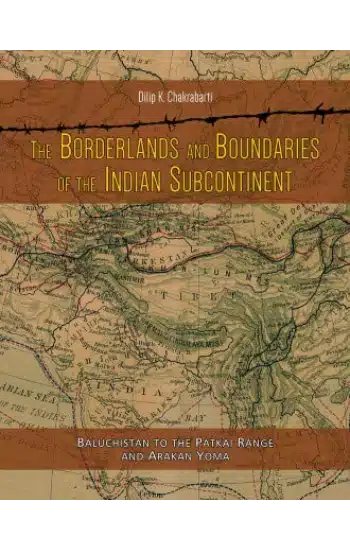
Save: 15%

Save: 15%
The Borderlands And Boundaries Of The Indian Subcontinent: Baluchistan To The Patkai Range And Arakan Yoma
Publisher:
| Author:
| Language:
| Format:
Publisher:
Author:
Language:
Format:
₹1,950 ₹1,658
Save: 15%
In stock
Ships within:
In stock
| Book Type |
|---|
ISBN:
Page Extent:
This volume has sought to examine the basic elements of geographical, historical, economic and religious interactions between the accepted outer boundary line of the Indian subcontinent and the major geographical zones which lie outside it. The various boundary lines, which were drawn from time to time in the late nineteenth and early twentieth centuries to define the sub-continent in relation to its overland neighbours, were the products of the contemporary political circumstances and the consensus between the negotiating governments, but behind the apparent precision of these boundary lines lies hidden an interaction zone of what we may call ‘borderlands’, stretching from Baluchistan at one point and the Arakan Yoma hills at another.
The character of these borderlands varies from one geographical sector to another, depending on a host of circumstances such as their physical geography both inside and outside the boundary line they follow, the historical circumstances which have developed across the borders, and the trading and religious networks which have been woven across them. An awareness or examination of these issues will help us to geopolitically appreciate how the subcontinent has figured in the historical and cultural world of the Asian landmass.
The maritime aspects of this relationship are increasingly becoming matters of historical discussion under the garb of investigating the relationships between different participants in the trade of the Indian Ocean and the related world. As far as the overland links are concerned, this relationship has not yet strongly emerged as a field of historical-geographical study. It is far more than being a case of the study of geo-political factors which change both with technology and political circumstances. It is basically a question of feeling the historical pulse of a vast, diverse and yet in a sense interlinked arena. An understanding of these links may also help us to look critically at many general premises regarding the geography and history of the subcontinent, premises which have regrettably persisted for long without close examinations of the concerned ground realities. On a different level, the volume also offers a comprehensive view of the civilizational impact of the subcontinent across its overland limits.
This volume has sought to examine the basic elements of geographical, historical, economic and religious interactions between the accepted outer boundary line of the Indian subcontinent and the major geographical zones which lie outside it. The various boundary lines, which were drawn from time to time in the late nineteenth and early twentieth centuries to define the sub-continent in relation to its overland neighbours, were the products of the contemporary political circumstances and the consensus between the negotiating governments, but behind the apparent precision of these boundary lines lies hidden an interaction zone of what we may call ‘borderlands’, stretching from Baluchistan at one point and the Arakan Yoma hills at another.
The character of these borderlands varies from one geographical sector to another, depending on a host of circumstances such as their physical geography both inside and outside the boundary line they follow, the historical circumstances which have developed across the borders, and the trading and religious networks which have been woven across them. An awareness or examination of these issues will help us to geopolitically appreciate how the subcontinent has figured in the historical and cultural world of the Asian landmass.
The maritime aspects of this relationship are increasingly becoming matters of historical discussion under the garb of investigating the relationships between different participants in the trade of the Indian Ocean and the related world. As far as the overland links are concerned, this relationship has not yet strongly emerged as a field of historical-geographical study. It is far more than being a case of the study of geo-political factors which change both with technology and political circumstances. It is basically a question of feeling the historical pulse of a vast, diverse and yet in a sense interlinked arena. An understanding of these links may also help us to look critically at many general premises regarding the geography and history of the subcontinent, premises which have regrettably persisted for long without close examinations of the concerned ground realities. On a different level, the volume also offers a comprehensive view of the civilizational impact of the subcontinent across its overland limits.
About Author
Reviews
There are no reviews yet.
Related products
Burhanpur: Unexplored History, Monuments And Society
Save: 15%
The Sacred Landscape Of Mundeshwari: The ‘Oldest Living’ Temple
Save: 15%
Harappan Studies: Recent Researches In South Asian Archaeology (Vol. Ii)
Save: 15%
RELATED PRODUCTS
Early History Of Varanasi: Recent Excavations At Rajghat
Save: 15%
Eighteenth Century Deccan: Cultural History Of The Peshwas
Save: 15%
Glory Of The Kushans: Recent Discoveries And Interpretations
Save: 15%
Harappan Studies: Recent Researches In South Asian Archaeology (Vol. Ii)
Save: 15%
India, Central Asia And Russia: Three Millennia Of Contacts
Save: 15%
Maritime Trade And Overseas Activities Of Early India: Odishan Perspective
Save: 15%
Ornamentation In Indian Architecture: Oriental Motifs And Designs
Save: 15%
Rockcut Temples Of South India: Architectural Dimensions
Save: 15%
Royal Messages By The Wayside: Historical Geography Of The Asokan Edicts
Save: 15%
The Dussehra Of Kulu: History And Analysis Of A Cultural Phenomenon
Save: 15%
The Sacred Landscape Of Mundeshwari: The ‘Oldest Living’ Temple
Save: 15%
The Silk Road: Trade, Caravan Serais, Cultural Exchanges And Power Games
Save: 15%
Women And Gender In Ancient Inida: A Study Of Texts And Inscriptions
Save: 15%



Reviews
There are no reviews yet.